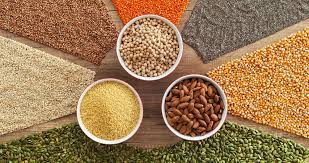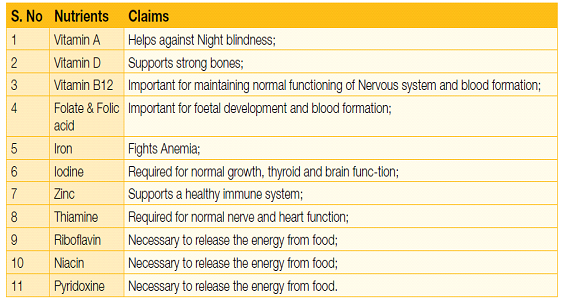Description

Copyright infringement not intended.
Context
- The Union Cabinet approved a scheme to distribute fortified rice under government programmes.
- Food Corporation of India and state agencies have already procured 88.65 LMT (lakh tonnes) of fortified rice for supply and distribution.
Food Fortification Recent Developments
- The Ministry of Consumer Affairs, Food and Public Distribution had launched a centrally sponsored pilot scheme on “Fortification of Rice and its Distribution under Public Distribution System (PDS)” for a period of three years beginning 2019-20 with a total budget outlay of Rs.174.64 crore. The pilot scheme focuses on 15 districts in 15 states. Under the scheme, the blending of rice is done at the milling stage.
- Maharashtra and Gujarat have started distribution of fortified rice under PDS in the Pilot Scheme.
- The Scheme is funded by the Government of India in the ratio of 90:10 in respect of North Eastern, hilly and island states and 75:25 in respect of the rest.
- India is considering compulsory fortification of rice from 2024 as a significant percentage of the population continues to suffer from malnutrition and anemia.
Food Fortification
- The Food Safety and Standards Authority of India (FSSAI) defines fortification as "deliberately increasing the content of essential micronutrients in a food so as to improve the nutritional quality of food and to provide public health benefit with minimal risk to health".
- For example, adding iodine and iron to edible salt.
What is the need for Fortification in India?
Hunger and Malnutrition
- India has very high levels of malnutrition among women and children. According to the Food Ministry, every second woman in the country is anaemic and every third child is stunted.
- Malnutrition is the primary reason behind 69 per cent of deaths of children below the age of five in India, according to a UNICEF’s The State of the World’s Children 2019 report. The report further states that every second child in India, under five years of age, is affected by some form of malnutrition.
- Malnutrition prevents brain development, body growth, immune systems from working effectively, and increases lifelong risk of disease and disability.
- In the 2021 Global Hunger Index, India ranked 101st out of the 116 countries.
- Over 70 percent of India’s population still consumes less than 50 percent of RDA for micro-nutrients.
- One third of India’s population is suffering from vitamin and micro-nutrient deficiencies globally, are in India.
- The control of micronutrient deficiencies is an essential part of the overall effort to fight hunger and malnutrition.
- India has been implementing a variety of strategies to address anaemia and micronutrient deficiencies which include iron-folic acid supplementation, vitamin A supplementation, nutrition health education to encourage dietary diversity, and others. However, the anaemia levels continue to be high.
- This, therefore, requires the introduction of strategies such as food fortification which are evidence based, tried and tested in other parts of the world.

Copyright infringement not intended.
Rice Fortification
- Fortification of food is considered to be one of the most suitable methods to combat malnutrition. Rice is one of India’s staple foods, consumed by about two-thirds of the population. Per capita rice consumption in India is 6.8 kg per month. Therefore, fortifying rice with micronutrients is an option to supplement the diet of the poor.
- It has the potential to help aid vulnerable populations.
- Rice kernels can be fortified with several micronutrients, such as iron, folic acid and other B-complex vitamins, vitamin A and zinc.
- Similarly, other vital micronutrients can be added to staples like wheat flour, oil, and milk.
- The reason behind choosing staple items is to reach a larger population.
- According to the FSSAI norms, 1 kg fortified rice shall contain iron (28mg-42.5mg), folic acid (75-125 microgram) and Vitamin B-12 (0.75-1.25 microgram).
- In addition, rice may also be fortified with micronutrients, singly or in combination, at the level– zinc, Vitamin A, Vitamin B1, Vitamin B2, Vitamin B3 and Vitamin B6 per Kg.
Technologies used in Fortification
- Various technologies are available to add micronutrients to regular rice, such as coating, dusting, and ‘extrusion’.
- Extrusion involves the production of fortified rice kernels (FRKs) from a mixture using an ‘extruder’ machine. It is considered to be the best technology for India.
- The fortified rice kernels are blended with regular rice to produce fortified rice.
Extrusion Technology Mechanism
- Dry rice flour is mixed with a premix of micronutrients, and water is added to this mixture. The mixture is passed through a twin-screw extruder with heating zones, which produces kernels similar in shape and size to rice. These kernels are dried, cooled, and packaged for use. FRK has a shelf life of at least 12 months.
- As per guidelines issued by the Ministry of Consumer Affairs, Food and Public Distribution, the shape and size of the fortified rice kernel should “resemble the normal milled rice as closely as possible”.
- According to the guidelines, the length and breadth of the grain should be 5 mm and 2.2 mm respectively.
Standards for fortification
- Under the Ministry’s guidelines, 10 g of FRK must be blended with 1 kg of regular rice.
- According to FSSAI norms, 1 kg of fortified rice will contain the following: iron (28 mg-42.5 mg), folic acid (75-125 microgram), and vitamin B-12 (0.75-1.25 microgram).
- Rice may also be fortified with zinc (10 mg-15 mg), vitamin A (500-750 microgram RE), vitamin B-1 (1 mg-1.5 mg), vitamin B-2 (1.25 mg-1.75 mg), vitamin B-3 (12.5 mg-20 mg) and vitamin B-6 (1.5 mg-2.5 mg) per kg.
Does fortified rice have to be cooked differently?
- The cooking of fortified rice does not require any special procedure. The rice needs to be cleaned and washed in the normal way before cooking.
- After cooking, fortified rice retains the same physical properties and micronutrient levels as it had before cooking.
India’s capacity for fortification
- Nearly 2,700 rice mills had installed blending units for production of fortified rice, and India’s blending capacity stood at 13.67 lakh tonnes in 14 key states. FRK production had increased rapidly from 7,250 tonnes to 60,000 tonnes within 2 years.
- An investment of Rs 15-20 lakh would be required to upgrade a rice mill of operating capacity 4-5 tonnes/hour.
- The Ministry had estimated that the cost of producing FRK with iron, folic acid, and vitamin B-12 would be around Rs 0.60 per kg.
How can a beneficiary distinguish between fortified rice and regular rice?
- Fortified rice will be packed in jute bags with the logo (‘+F’) and the line “Fortified with Iron, Folic Acid, and Vitamin B12”.
https://indianexpress.com/article/explained/what-is-fortified-rice-how-is-it-prepared-7860432/












